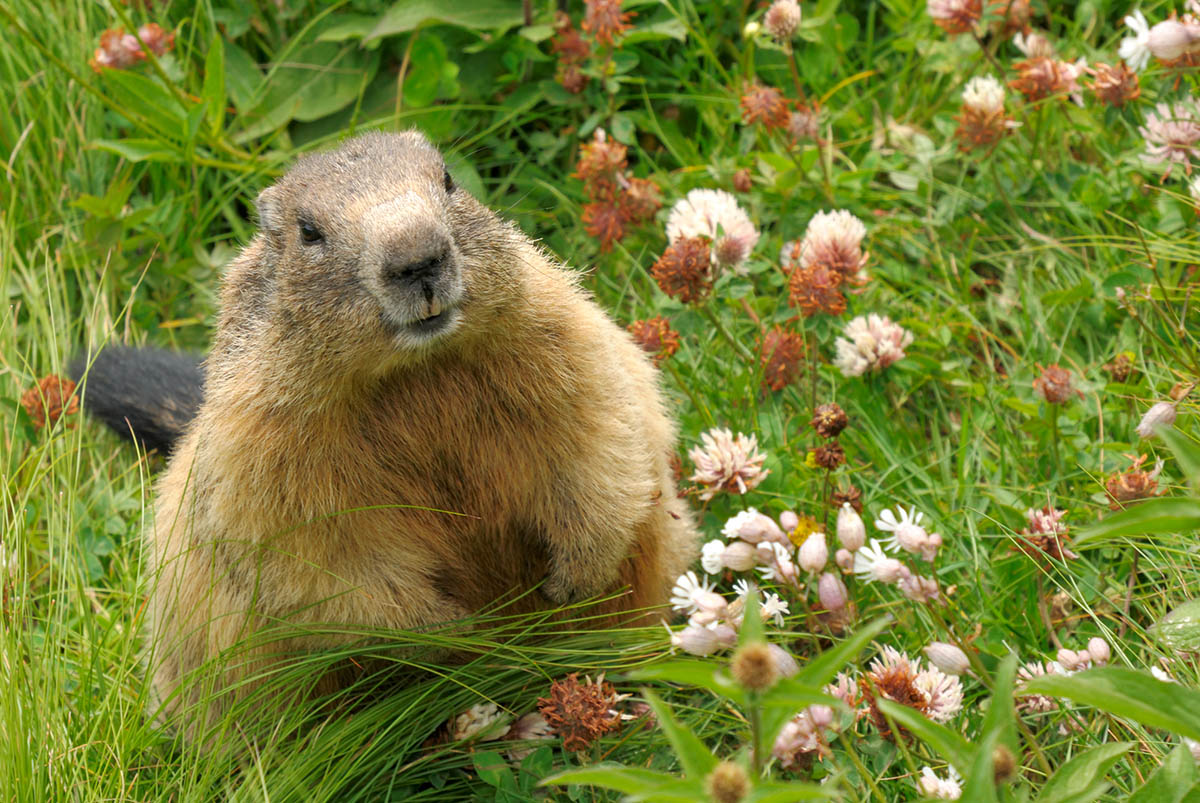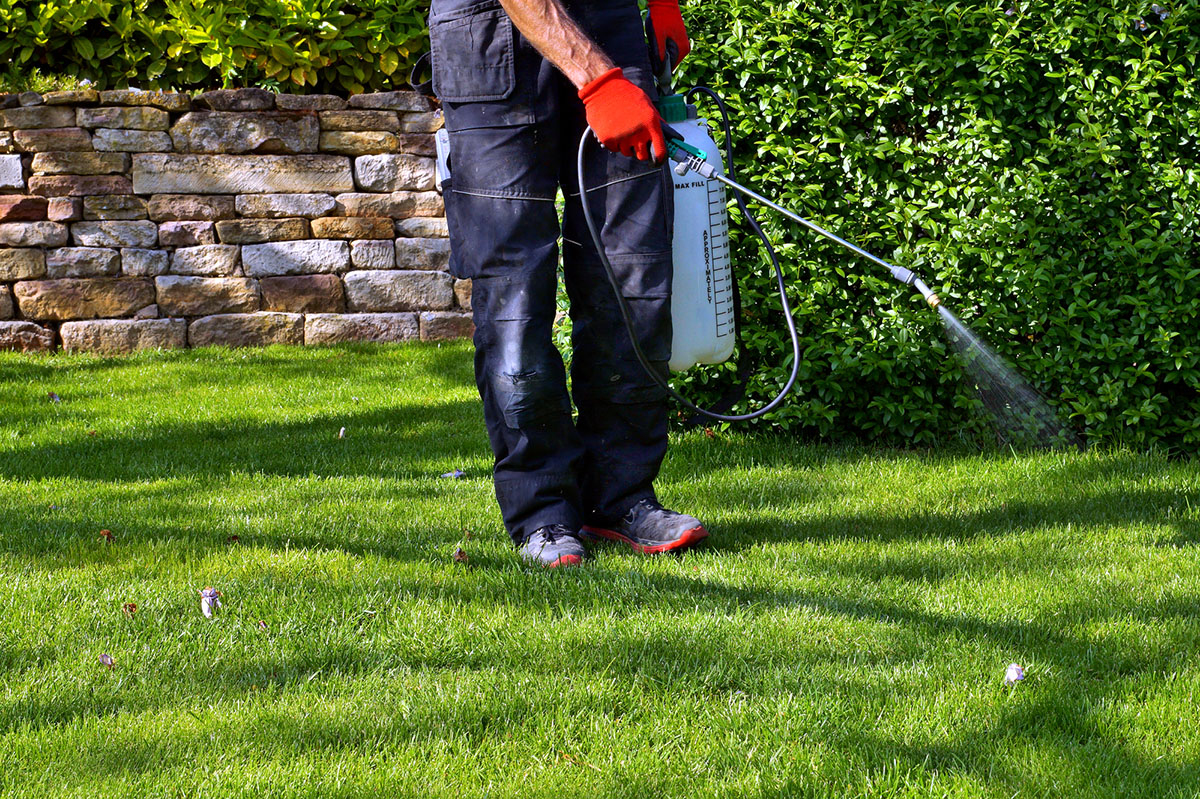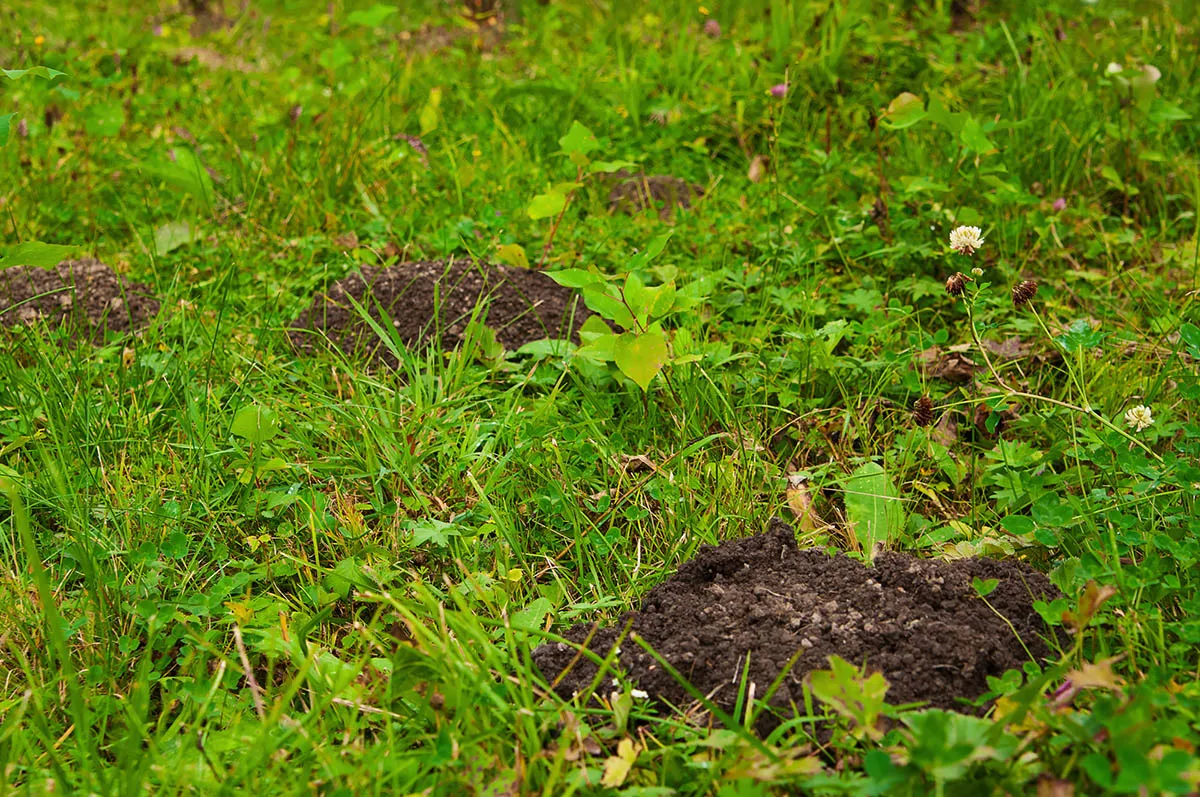

We may earn revenue from the products available on this page and participate in affiliate programs. Learn More ›
Project Overview
- Groundhogs can wreak havoc on a yard, but getting rid of them can be tricky.
- Homeowners can deter groundhogs using repellents and harassment methods to encourage them to move elsewhere.
- Trapping and relocating a groundhog is an option, but there may be state requirements about how to do so safely and humanely.
- If other methods fail, homeowners are advised to contact a wildlife removal professional to help remove groundhogs from their yard.
But what attracts groundhogs to people’s yards? It all comes down to the answer to one question, and that’s “What do groundhogs eat?” A woodchuck’s diet consists of flowers, vegetables, twigs and bark, bugs, and even plant seedlings—so much of a home garden is fair game for these critters, which is why they often make their home near someone’s garden. Deep tunnels and nibbled crops are two telltale signs of a groundhog problem. But luckily, there are a few ways to combat this situation. This guide explains how to get rid of groundhogs and keep them away for good.
When people think of groundhogs, they may picture Punxsutawney Phil or think of the fascinating history of Groundhog Day. But groundhogs, also known as woodchucks, do more than just (allegedly) forecast the seasons. If they wander into a yard, they can cause significant damage to a home garden. They can even undermine the structural integrity of sheds, driveways, and foundations.
Time required: 3 to 5 days
Difficulty: Beginner to intermediate
Estimated cost: $150 to $200 for removal; cost for preventive measures (such as building fences) will vary
Tools & Materials
Bobvila.com may earn a commission from purchases made through these links.
Before You Begin
Before starting the groundhog removal process, homeowners will want to consider the following:
Tips for Getting Rid of Groundhogs
- Groundhogs can easily be mistaken for other similar rodents, such as gophers, voles, and moles (if moles are the primary culprits, the best mole repellents may get rid of them). The rodents’ appearance and tunnels or mounds can help homeowners differentiate them and apply the appropriate removal solutions.
- Consider the season and timing. Groundhogs reproduce from late winter until the spring or early summer and hibernate in the winter. The most humane time to get rid of woodchucks is from mid- to late summer to avoid separating a mother from her babies.
Safety Considerations
- While groundhogs, like other rodents, are not a significant source of infectious disease to humans, they occasionally can carry rabies. It’s a good idea to treat any unprovoked attack as a potential rabies exposure.
- If you are not comfortable with removing groundhogs yourself or cannot safely implement the strategies below, consider hiring a professional groundhog removal service.
5 Things You Can Do to Deter Groundhogs
1. Prevent nesting by maintaining your yard.
Groundhogs will use any yard debris they can find to make a nest. Keeping a tidy lawn that’s free of wood or leaf piles and garbage can help homeowners prevent these rodents from nesting in the first place. Groundhogs may also burrow underneath homes or garages—if there is already a groundhog nest somewhere in the yard, homeowners will want to fill in any holes and block off the area to keep them from returning to the spot.
2. Use repellents to keep them away.

While there are no commercial chemical repellents designed specifically for groundhog removal, products designed for other rodents may do the trick. For homeowners who have dogs, another option is to sprinkle dog urine or fur around the groundhog’s nest to indicate that predators are nearby. Bobcat urine can also be purchased from home improvement or hardware stores for this same purpose and may be even more effective. Epsom salt is a useful groundhog deterrent and repellent that many homeowners may already have on hand. Ammonia, red pepper flakes, talcum powder, and garlic also make suitable woodchuck repellents and are often found in the home.
Another option is a motion-detector groundhog repellent device that sprays water or flashes light to startle the animals when they approach the device.
To get rid of groundhogs, homeowners will want to plan out an exit route away from the property, then place the repellent in the burrows nearest the property. They will place another repellent in burrows farther away (closer to the exit) 1 or 2 days later, repeating the process as necessary until the groundhogs are gone. It’s advised that homeowners exercise caution when plotting out an exit point, or the woodchucks may become the neighbors’ problem.
3. Drive the groundhogs out of their homes.
Making a groundhog’s home uninhabitable can drive the critter out. One standard solution is to flood the groundhog hole with water, which causes it to look for drier land. Another thing to try is filling the burrow with dirt or rocks.
Ideally, fumigation will only be performed as a last resort, and always by a wildlife removal specialist. The fumigation process is not only dangerous to humans but can be lethal to animals. It is also likely to wreak havoc on the lawn. According to Thomas Ward III, a training specialist and biologist with Critter Control, the solution to a wildlife nuisance does not have to be deadly to be effective. “Just because we’re solving a wildlife problem doesn’t mean we have to hurt the animal,” he says. “We’ll always look at options that don’t cause direct harm to the animal.” When hiring a professional, homeowners will want to make sure that the company they choose employs non-lethal methods.

Tried-and-True Advice
“I started using a trail camera to monitor groundhog activity in my yard, and it’s been a game changer. Instead of constantly checking for new holes or damage, I just set up the camera near the burrows or trouble spots. Since it’s motion-activated, it records whenever something moves, usually a groundhog sneaking around at odd hours.
Watching the footage gave me a much better understanding of when and where they’re most active. I was able to spot their entry points and even pinpoint peak times, which made it way easier to set traps and deterrents more effectively. It’s a super efficient, low-effort way to stay ahead of the problem without being out there 24/7.”
—Paul Rankin, Contributing Editor and Writer
4. Scare groundhogs out of their homes.
If a groundhog won’t leave its home willingly, another course of action is to scare it out of its burrow, and hope it takes shelter elsewhere. While visual scare tactics such as scarecrows and pinwheels do work in the short term, they rarely provide lasting relief as the critters get used to them. Auditory and tactile tools, such as solar stakes that send out ultrasonic pulses, tend to be more effective in the long run for scaring away groundhogs and other digging pests. But Ward advises that these tactics can be limited in their usefulness: “Sometimes harassment methods work; if you bother [the groundhog] enough, it might go away. That can be hit or miss because it doesn’t really direct it where to go; it’s just directing it away, so you might send it to your neighbor’s house.” The groundhog would then become the neighbor’s problem, and there’s a chance they will inadvertently drive the rodent back into your yard.
5. Trap and relocate the groundhogs.
A more foolproof way of protecting the yard from these pests is by physically relocating groundhogs from the property altogether. Ward says, “The typical method for trying to remove a groundhog would be a cage, or what we call a box trap, to capture and relocate a groundhog.” The process involves setting up groundhog traps near the burrow entrance. A piece of fruit works well as groundhog bait; these critters can’t resist a juicy piece of cantaloupe.
Once trapped, the animal can be released a significant distance away from the property so it can’t find its way back. Before you go outside toting a melon, though, make sure groundhog relocation isn’t illegal in your area. “You have to make sure [that state regulation] allows relocation or translocation of an animal because those regulations vary by state,” advises Ward. Some cities only allow relocation if it’s done by a professional wildlife specialist.
The Humane Society of the United States advises that relocation is not recommended in the spring and early summer because it could result in an orphaned litter that will die without their mother. Relocation can also disorient animals and lead to their untimely deaths. Leave wild animals alone unless they are causing damage to the property. In some cases, however, relocation is the best solution to get rid of groundhogs.
The bottom line? If you don’t want to deal with these legal questions and trapping scenarios on your own, consult a wildlife removal specialist.
“Just because we’re solving a wildlife problem doesn’t mean we have to hurt the animal. We’ll always look at options that don’t cause direct harm to the animal.”
– Thomas Ward III, training specialist and biologist with Critter Control
How to Prevent Groundhogs from Coming Back to Your Property
Install Fencing
In-ground fencing is one of the most effective options for keeping groundhogs out of gardens; however, you’ll have to take additional measures so the creatures cannot burrow underneath or climb over the fence. Before installing fencing, ensure that there are no inhabited burrows in the area. Otherwise, the groundhog may end up trapped inside the yard instead of out. Homeowners can do this by loosely placing material such as newspaper or grass clippings at the burrow entrance, then observing over a period of a few days to see whether the material has been disturbed.
Once it is clear that there are no groundhogs living in the yard, it’s time for to erect the fence. Hardware cloth and chicken wire are both affordable and effective options. Perimeter fences will need to be at least 3 feet high and buried 12 inches underground. The top 15 inches of the fence can be bent at an angle to discourage groundhogs from climbing over. An electric wire placed 4 to 5 inches off the ground around the fence provides additional protection. Hardware cloth can also be buried 1 foot into the ground to limit burrowing under decks and foundations.

Plant Groundhog Deterrents
If you’ve done any research on getting groundhogs off your property, chances are you’ve learned that some plants might deter groundhogs. “Repellents and deterrents have limited effectiveness in my experience,” says Ward. However, they can serve as an additional line of defense in conjunction with other methods. Groundhogs dislike the smell of herbs such as mint, sage, basil, rosemary, thyme, chives, and oregano. Planting these around the border of the yard or in places that need protection (such as a vegetable garden) may keep groundhogs from wandering in. But homeowners will want to note that a female groundhog is not likely to be deterred by something as trivial as an offensive odor if she is protecting her babies.
Often what is more effective than adding a deterrent is removing elements that are attracting groundhogs to the yard in the first place. For example, the ground underneath an apple tree that sheds fruit and leaves can turn into a groundhog snack bar. Clearing the yard of anything that could double as food or shelter for a groundhog will make it much less appealing to the rodents, and therefore decrease the likelihood of a groundhog returning to your yard (or a new one coming to take the original one’s place) once you’ve gotten rid of the rodent.
When to Call a Professional
Groundhogs are cute from a distance, and you might be tempted to interact with them. But Ward advises homeowners to take caution. “Groundhogs do get pretty big,” he says, cautioning that they have a forceful bite. “I always recommend caution when homeowners do something themselves, not because of lack of capability, but because you’re putting yourself at a bit more risk than you might want to or not realizing the potential risk.” He recommends weighing potential risks against calling a professional and letting them take care of the problem.
It’s important to remember that groundhogs are wild animals that do not always act predictably, especially if they are rabid. The best wildlife removal services will be able to advise homeowners on the safest and most effective course of action to remove groundhogs. They can also help to identify wildlife; some homeowners may not know the difference between gophers, groundhogs and beavers. The process for getting rid of gophers is similar to that of getting rid of groundhogs, but a professional can identify the animal and suggest the best methods for removing them from a property.
While groundhogs can be a nuisance, you can use the above tools and strategies to prevent and get rid of them for good. Keeping a neat lawn, planting natural deterrents, and installing the proper fencing can go a long way in stopping groundhogs from entering in the first place. If the above strategies are beyond your comfort level and expertise, find a professional with experience to help.
